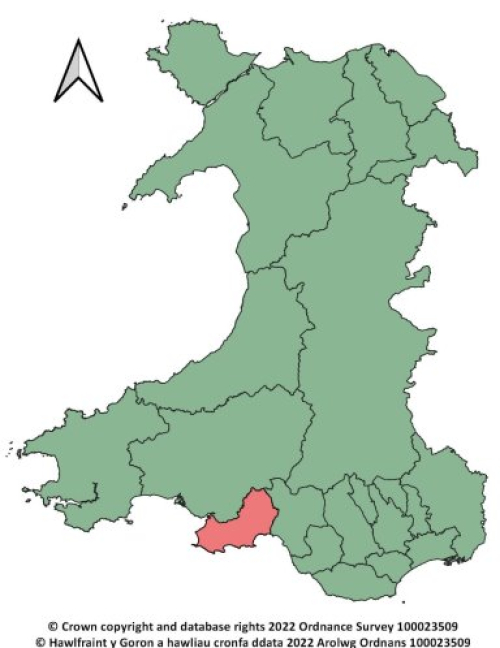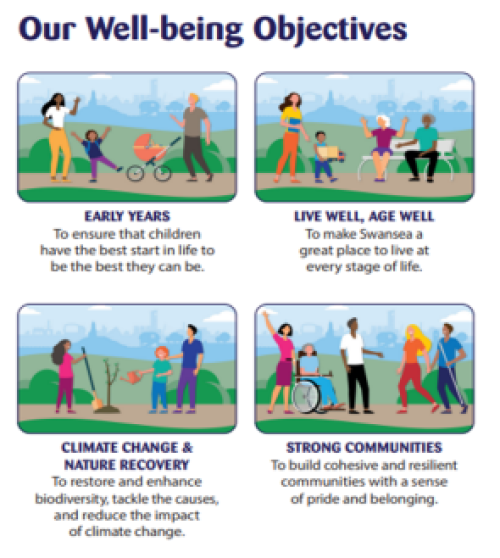LDP2 Preferred Strategy
2.0 Context
Geography and Place
2.1 Swansea is a unique place. It has a proud cultural history, world-renowned landscapes and an exciting range of urban, rural and coastal locations that provide a real contrast of experiences for residents and visitors.
2.2 In terms of its geography, Swansea is located on the south coast of Wales. The County extends from Rhossili Down at its Western edge, within the Gower National Landscape – Area of Outstanding Natural Beauty (AONB), across to Kilvey Hill and the slopes of the Drummau Mountain on its eastern edge. The southern boundary encompasses a stunning stretch of coastline along Swansea Bay to the Burry Inlet. To the north lies extensive rural hinterlands, including the vast open moorlands of the Lliw Uplands up to the ridge of Mynydd y Gwair overlooking the Amman Valley.
Figure 1 Map of Swansea in Context

2.3 The majority of the County's land area (approximately 380 square kilometres) is rural in character. These areas exhibit highly varied ecological habitats, within a range of landscape features, which includes internationally, nationally and locally designated ecological sites of importance and their associated species. An interim Green infrastructure (GI) Assessment undertaken to inform the Preferred Strategy and subsequent Deposit Plan (see Appendix A) identifies three main strategic GI asset areas across the County, namely the 'Gower National Landscape (AONB)' in the west, the 'City and Urban Fringes' in the centre, and the open rising landscape of 'the Mawr' north of the M4 corridor.
2.4 The latest official mid-year population estimates indicate there are 246,700 residents living in Swansea, making it the second most populous authority in Wales. People mainly reside within the 30% of the land area classified as urban settlements, which includes the second largest city centre conurbation in Wales, where high-density urban living coincides with significant commercial and business activity.
2.5 Swansea has a rich history of settlement growth that predates the Industrial age. The maritime city itself has Norman origins and was well-established by the Medieval period. As with much of Wales the Industrial Revolution led to considerable growth and transformative change, with further consolidation in the twentieth century when Swansea became the key focus for the wider industrial region. The legacy of this growth is a multi-layered network of close-knit communities, historic centres (some recognised by Conservation Area designations), and a sprawling post-industrial urban fabric. In terms of their character and function today, these places are diverse, ranging from the commercial focus of the city centre, a network of outer lying urban centres (some referred to locally as being 'towns'), suburban and semi-rural neighbourhoods, small rural villages/hamlets in the open countryside, and various coastal and riverside destinations. All of this forms a complex setting for the challenges of contemporary regeneration, delivering sustainable growth and understanding evolving neighbourhood identity in a global age.
2.6 Many of the historic Victorian urban areas of Swansea were fundamentally based on 'local living', comprising shops, schools and employment opportunities accessible by walking or public transport. These are often positive legacy references for the contemporary placemaking objectives to define mixed use vibrant centres, reducing the need to travel and creating pleasant environments for walking whilst still accommodating vehicles. Morriston, for example, is the earliest example of a planned industrial town in the British Isles. It is based on a Georgian grid with later Victorian buildings accommodating higher densities and range of mixed uses that help forge a cohesive community. Whilst some centres across the County have moved away from their former primary retail functions, such areas are evolving in the post pandemic digital age as mixed use areas and remain largely well-located for local transport networks. They continue to provide opportunities for sustainable living in terms of homes and access to jobs alongside a diversity of uses at the heart of local communities. Notwithstanding this, some centres have experienced degradation of their physical environments, and enhancements to these need to be targeted alongside strategies to sustain appropriate mixed uses. It is also important to recognise that the post war growth period did lead to the formation of some less cohesive suburb developments in Swansea with limited facilities, sometimes lacking in local identity. In some communities, particularly post-war municipal suburbs, there are issues of depravation, isolation and poor access to services and facilities.
2.7 It is important to highlight the wider regional context within which strategic planning for the County needs to take place. In this regard, Swansea lies at the heart of the Southwest Wales region, which itself is highly diverse in terms of place and has a population of over 700,000 people, including 147,864 Welsh speakers. Strategic connections across the County and beyond Swansea include the M4 motorway, a number of trunk roads, the strategic rail network (London – Fishguard line), and Swansea Port and Docks that has strategic links to Europe and beyond.
Legal Framework, National and Regional Context
2.8 It is important that LDP2 demonstrates compliance with all relevant Acts and legal duties. The Planning and Compulsory Purchase Act 2004 (as amended) requires the Council to prepare a Local Development Plan (LDP). The Planning (Wales) Act 2015 introduced a new statutory framework for Development Plans, constituting a legal basis for an interconnected framework of Plans at national, regional and local level. The Act also requires planning authorities, and other public bodies, to exercise its functions in accordance with the principles of sustainable development as set out in The Well-being of Future Generations (Wales) Act 2015. A number of other Acts also govern decision making on planning matters in Wales, including the Environment (Wales) Act 2016, the Active Travel (Wales) Act, Public Health Wales Act 2017, and the Equality Act 2010 and related Socio-economic Duty (March 2021).
2.9 LDP2 must be prepared having regard to the guidance published by the Welsh Government's Development Plans Manual, Edition 3, March 2020 (hereafter referred to as 'The Manual'). Most fundamentally, Plan preparation must consider:
- Has preparation of the Plan complied with legal and regulatory procedural requirements?
- Is the Plan in general conformity with the National Development Framework (Future Wales)?
2.10 LDP2 must meet the specific 'Tests of Soundness' set out in the Manual, which are:
- Test 1: Does the Plan fit? (is it clear the Plan is consistent with other plans?)
- Test 2: Is the Plan appropriate for the area in the light of the evidence?
- Test 3: Will the Plan deliver? (is it likely to be effective?)
2.11 A 'Self-Assessment' of the Preferred Strategy against the Tests of Soundness has been prepared to accompany the publication of this document (see list of documents at Appendix A).
2.12 Future Wales - The National Plan 2040 (Welsh Government, February 2021) is the approved national development plan for Wales and sets the strategic vision and direction for how development should come forward in all areas of the country. Planning Policy Wales (edition 12 February 2024 - PPW) sets out national land use planning policies. PPW is supplemented by a series of Technical Advice Notes (TANs), Circulars and policy clarification letters. Collectively these provide the national planning policy framework for Wales. In order to be found an acceptable or a 'sound' Plan, LDP2 must be broadly consistent with national policy.
2.13 The Council is a signatory of the Placemaking Wales Charter. As a signatory, the Council pledges to:
- Involve the local community in the development of proposals
- Choose sustainable locations for new development
- Prioritise walking, cycling and public transport
- Create well defined, safe, and welcoming streets and public spaces
- Promote a sustainable mix of uses to make places vibrant
- Value and respect the positive distinctive qualities and identity of existing places
LDP2 will be a key mechanism to ensure that the Council delivers on these pledges.
2.14 With regard to the regional context, the Planning Act put in place a new framework for strategic planning in Wales and has facilitated the constitution of the South West Wales Corporate Joint Committee (CJC). This new regional body published its Corporate Plan for 2023-2028 and will take forward the requirements to deliver a Strategic Development Plan (SDP) for the South West Region. Initial key stages of the South West Wales SDP are likely to be progressed from 2025 onwards, however it is anticipated that the production of the detailed Plan will follow adoption of LDP2.
2.15 LDP2 must be broadly aligned to national policies pertaining to the region. Future Wales estimates the level of additional housing need for the South West region as being around 25,600 new homes (from 2019 – 2039) and these estimates should form part of the evidence base and context on which future housing requirements are developed. It identifies the Swansea Bay and Llanelli urban area as being the main focus for future development in the region to meet this need, going as far as to define it as a National Growth Area (NGA) – one of only 3 across Wales. The Swansea Bay and Llanelli NGA Definition Project Research Report, January 2023, (see Appendix A) highlights the findings of a project that has assessed the constraints and opportunities across this area to arrive at a more accurate understanding of the land within the NGA that can realistically be considered potentially suitable for development, including for housing.
2.16 An LDP2 Background Paper on regional collaboration has been prepared in partnership with adjoining authorities (see Appendix A). It confirms that LDP2 has been prepared in full recognition of the importance of collaboration, having regard to the requirements of Future Wales and meeting the Tests of Soundness. It also sets out the opportunities that have been taken to collaborate on a number of evidential facets, including a Regional Stage 1 Strategic Flood Consequences Assessment and an Economic and Housing Growth Assessment, together with the sharing of methodologies on other underpinning evidence. The Regional Collaboration Background Paper provides an update of the stages of replacement LDP preparation for all authorities within the South West Region and sets out how ongoing collaboration will extend into the formation of the Deposit Plan.
Local Policy Context
2.17 The Council's Corporate plan 2023 / 2028 describes the Council's overarching vision for Swansea. It sets out the 6 key council priorities (well-being objectives) and organisational values and principles that will underpin the delivery of these priorities. The corporate plan aligns with a number of supporting strategic plans that set out local objectives, including the Human Rights and Strategic Equality Plan 2024 - 2028 - Swansea, Digital strategy - Swansea and Welsh language Plan - Swansea. LDP2 provides a means to drive sustainable economic growth alongside the Council's ambitions for enhancement of the area's natural assets, and to support the achievement of all objectives relating to land use and well being more broadly.
2.18 Also at the local level, the Swansea Public Service Board has produced a Local Well-Being Plan 2023-28 under the terms of the Well-Being Act. This provides a blueprint for how stakeholders can best work together to improve well-being and is based on an Assessment of local well-being in Swansea undertaken in 2022. LDP2 will provide a means to deliver upon its content, most notably those elements that have a spatial / land use component.
Figure 2 Local Well-being Plan objectives

2.19 The existing adopted Swansea LDP 2010-2025 also provides an important local policy context. The findings of the statutory review into the current LDP demonstrated that the majority of its policies and proposals have been implemented successfully and as intended following adoption, delivering positive outcomes for people and places. As such, this review serves to focus the work on preparation of LDP2 to particular areas of evidence, strategy and policy that require refinement.
2.20 The LDP2 ISA Scoping Report provides a comprehensive, more detailed analysis of the range of pertinent plans, policies, strategies and programmes that influence the formation of LDP2, which includes those at national, local and regional level.

